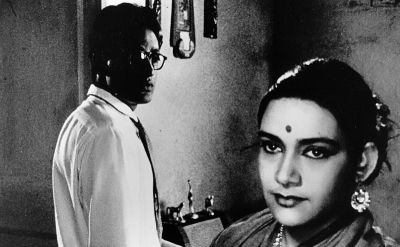
MEGHE DHAKA TARA
(The Cloud-Capped Star/La stella nascosta, India/1960) R.: Ritwik Ghatak. D.: 126'. V. bengalese
Introducono Shivendra Singh Dungarpur e Gian Luca Farinelli
Il linguaggio cinematografico è un linguaggio universale e, allo stesso tempo, profondamente nazionale. Vale a dire che bisogna far fondere queste due dimensioni l'una nell'altra attingendo ai simboli e agli archetipi del nostro paese. [...] È perché, sì, evidentemente, io mi ispiro ad alcuni modelli stranieri. Bisogna rubare ai grandi maestri, a quello che c'è di universale. Una certa dose di assimilazione, un'altra di sintesi, ecco di cos'è fatta questa ricerca. Noi abbiamo cercato di creare una corrente. Ma eravamo solo degli individui, come tanti uccelli solitari. All'epoca, la situazione del paese rendeva impossibile ogni movimento unitario. Io sentivo le cose alla mia maniera; gli altri alla loro e tuttavia c'è stata sempre un'unica e comune ricerca.
Ogni artista ha il dovere di preservare la propria capacità di stupore, di rimanere interiormente vigilante ed eternamente vergine. Senza questa facoltà gli sarà impossibile compiere grandi cose. Il sottile segreto che si nasconde dietro ogni atto di creazione consiste sostanzialmente nel soffermare il proprio sguardo su ogni cosa, nel fissarla in una silenziosa meraviglia, nel lasciarsi affascinare da qualche oggetto passeggero o nell'abbandonarsi alla pienezza del piacere, poi dopo lungo tempo, venuta la tranquillità, nell'estirpare questo sentimento intimo dal granaio del proprio spirito, dargli una forma e soffiargli la vita. In un modo o nell'altro, ogni artista riesce a trasportare con sé la propria infanzia, la conserva nascosta in tasca fino all'età adulta. Se gli sfugge, non è più che un vecchio barbogio; ha cessato di essere un artista e diviene un teorico. L'infanzia è uno stato mentale estremamente fragile, uno stato di ripiegamento in se stessi, alla maniera di quelle piante selvatiche e delicate che appassiscono al minimo contatto. Al contatto grossolano del quotidiano, l'infanzia si sfalda, avvizzisce e perde la sua energia.
Ogni artista ha forzatamente conosciuto questa esperienza.
(Ritwik Ghatak)
Aggiungete le linee oblique, gli alberi, le rive del fiume, il treno, che sembrano perdere l'equilibrio a causa della tensione tra il vuoto e il pieno. Aggiungete il canto, le sue rincorse, i suoi terreni scoscesi, le sue cadute, le sue risalite improvvise, il rumore del treno che lo attraversa sdoppiandone e affrettandone il ritmo. Aggiungete i movimenti spasmodici di Shankar. La lenta variazione degli spostamenti di Nita. Otterrete un'immagine nella quale, con tre inquadrature semplicissime, Ghatak conferisce al suo film una modulazione fatta di scontri e conflitti, qui ancora contenuti, e un disequilibrio formale in ogni istante, come un'eco al disequilibrio storico e personale che costituisce lo sfondo melodrammatico a tutti i suoi film: la divisione del Bengala.
(Raymond Bellour)
The language of film is universal and deeply national all at once. That is to say that these two dimensions must be made one by drawing on the symbols and archetypes of our country. [...] It is the reason why, yes, I am obviously inspired by a few foreign models. The great masters should be stolen from, what is universal as well. A certain amount of assimilation, another of synthesis, that's what this search is made of. We tried to create a movement. But we were just individuals, like many solitary birds. At the time, the country's situation made any unified movement impossible. I felt things in my own way; everyone else in theirs, and nevertheless there was always this one, common search.
Every artist has the duty to preserve his capacity to be surprised, to be internally vigilant and eternally virgin. Without this ability, it will be impossible for him to achieve great things. The subtle secret concealed in every act of creation basically consists in pausing to observe every single thing, in capturing it in a silent wonder, in being enchanted by a passing object, or giving in to pleasure's totality, and then after a long time, once the calm has returned, in uprooting this intimate feeling from within one's own spirit, giving it form, and breathing life into it. In one way or another, every artist manages to carry his childhood with him, keeps it in his pocket into adulthood. If it eludes him, he is nothing more than a fogey; he ceases to be an artist and becomes a theorist. Childhood is an extremely fragile state of mind, a state of folding in on oneself, like those wild yet delicate plants that wither at the slightest touch. Childhood crumbles, withers and loses its energy with the crude touch of the everyday.
Every artist has had this experience.
(Ritwik Ghatak)
Add the oblique lines, trees, river banks, the train, which seem to lose their balance due to the tension between empty and full. Add the song, its surges, its subtle plains, its falls and sudden rises, the train noise that cuts through it, dividing and accelerating the rhythm. Add Shankar's spasmodic gestures. The slow variation of Nita's movements. Then you have an image in which, in three very simple shots, Ghatak creates a modulation fed by collisions and conflicts, here still contained, and a formal imbalance in every moment, like an echo of the historical and personal imbalance that creates the melodramatic backdrop to all his films: the partition of Bengal.
(Raymond Bellour)

Il Cinema Ritrovato 2012
 Passaggio in India. Breve omaggio di cinefili a cinefili
Passaggio in India. Breve omaggio di cinefili a cinefili
Tariffe:

Numero posti: 174
Aria Condizionata
Accesso e servizi per disabili
Il nostro cinema aderisce al circuito CinemAmico: è possibile utilizzare l’applicazione MovieReading® per i film di cui è prevista audiodescrizione e/o sottotitolazione sull'applicazione.
Tel. 051 2195311










